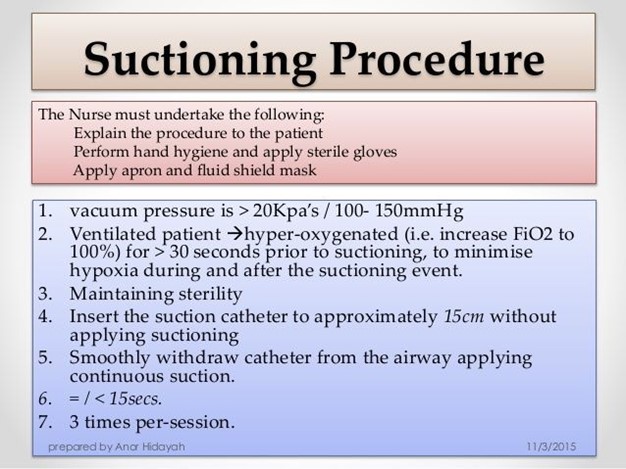56. The practical nurse (PN) is caring for a client who has a tracheostomy tube. After donning sterile gloves, in which sequence should the PN should implement these interventions? (Arrange from the first action on top to last on the bottom.)
Insert sterile suction catheter in tracheostomy tube.
Hyperoxygenate with a bag valve mask (BVM) using a nondominant hand.
Activate suction by covering the catheter opening.
Withdraw and rotate the catheter while suction is applied.
The Correct Answer is B, A, C, D
The correct sequence for the interventions when caring for a client with a tracheostomy tube, after donning sterile gloves, is as follows:
Hyperoxygenate with a bag valve mask (BVM) using a nondominant hand. Insert sterile suction catheter in tracheostomy tube.
Activate suction by covering the catheter opening. Withdraw and rotate the catheter while suction is applied.
The first step is to hyperoxygenate the client using a bag valve mask (BVM) with the nondominant hand. This helps to ensure that the client receives adequate oxygenation during the suctioning procedure.
Next, the sterile suction catheter is inserted into the tracheostomy tube. The catheter is carefully advanced until resistance is met, ensuring it does not force its way in.
After the catheter is inserted, the suction is activated by covering the catheter opening. This creates negative pressure and allows for the removal of secretions.
Finally, the catheter is withdrawn and rotated while suction is applied. This helps to thoroughly suction the secretions from the tracheostomy tube.

Nursing Test Bank
Naxlex Comprehensive Predictor Exams
Related Questions
Correct Answer is D
Explanation
A thready pulse refers to a pulse that is weak and difficult to palpate. It may disappear or weaken with light pressure. This can be an indication of decreased peripheral perfusion or reduced blood volume. By documenting the finding as "Thready pulse volume," the nurse is accurately describing the quality of the pulse and its response to light pressure.
Incorrect:
A. Missing pulse: A missing pulse would mean that the pulse is not palpable at all, even without applying pressure.
B. Light pressure applied to pulse: This is not a description of the pulse quality, but rather a description of the action taken to assess the pulse.
C. Pulse skips beats: This would mean that the pulse is irregular, with beats being missed or added. In this case, the pulse disappears when light pressure is applied and returns when the pressure is removed, which describes a thready pulse volume.
Correct Answer is B
Explanation
Explanation: In this scenario, the sudden regurgitation and cyanosis in a 24-hour-old infant indicate a potential airway obstruction or compromise. The immediate priority is to clear the airway and ensure adequate ventilation.
Suctioning the oral and nasal passages helps remove any potential obstruction or mucus that may be causing the cyanosis. This intervention aims to restore normal airflow and prevent further respiratory distress in the infant.
Let's briefly evaluate the other options:
A) Turn the infant onto the right side.
Positioning the infant on the right side does not directly address the potential airway obstruction or cyanosis. While positioning may have some benefit in certain situations, such as facilitating drainage, it is not the most appropriate immediate intervention in this case.
C. Give oxygen by positive pressure.
Administering oxygen by positive pressure may be necessary if the infant's oxygen saturation remains low after suctioning and clearing the airway. However, suctioning should be the initial intervention to address any potential airway obstruction or mucus before considering oxygen administration.
D.Stimulate the infant to cry.
Stimulating the infant to cry is not the appropriate intervention in this case. It does not directly address the potential airway obstruction or cyanosis. Crying requires a patent airway, and if the infant is already cyanotic, it suggests an obstruction or inadequate ventilation. Therefore, suctioning and clearing the airway takes precedence over stimulating the infant to cry.
In summary, when a full-term, 24-hour-old infant in the nursery regurgitates and suddenly turns cyanotic, the practical nurse should immediately suction the oral and nasal passages to clear any potential airway obstruction or mucus. This intervention aims to restore normal airflow and ensure adequate ventilation for the infant.

Whether you are a student looking to ace your exams or a practicing nurse seeking to enhance your expertise , our nursing education contents will empower you with the confidence and competence to make a difference in the lives of patients and become a respected leader in the healthcare field.
Visit Naxlex, invest in your future and unlock endless possibilities with our unparalleled nursing education contents today
Report Wrong Answer on the Current Question
Do you disagree with the answer? If yes, what is your expected answer? Explain.
Kindly be descriptive with the issue you are facing.
